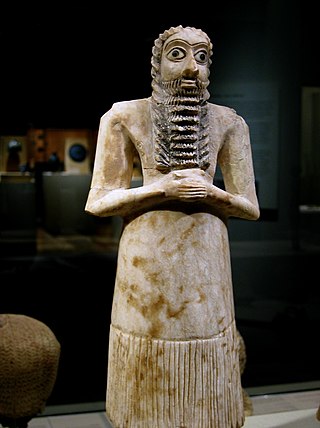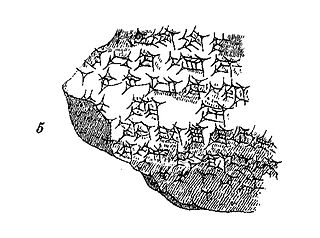Related Research Articles

Ninḫursaĝ sometimes transcribed Ninursag, Ninḫarsag, or Ninḫursaĝa, also known as Damgalnuna or Ninmah, was the ancient Sumerian mother goddess of the mountains, and one of the seven great deities of Sumer. She is known earliest as a nurturing or fertility goddess. Temple hymn sources identify her as the "true and great lady of heaven" and kings of Lagash were "nourished by Ninhursag's milk". She is the tutelary deity to several Sumerian leaders.
Akkadian literature is the ancient literature written in the Akkadian language in Mesopotamia during the period spanning the Middle Bronze Age to the Iron Age.

Nippur was an ancient Sumerian city. It was the special seat of the worship of the Sumerian god Enlil, the "Lord Wind", ruler of the cosmos, subject to An alone. Nippur was located in modern Nuffar in Afak, Al-Qādisiyyah Governorate, Iraq. It is roughly 200 kilometers south of modern Baghdad and about 60 miles southeast of the ancient city of Babylon. Occupation at the site extended back to the Ubaid period, the Uruk period, and the Jemdet Nasr period.

Ninurta (Sumerian: 𒀭𒊩𒌆𒅁: DNIN.URTA, possible meaning "Lord [of] Barley"), also known as Ninĝirsu (Sumerian: 𒀭𒎏𒄈𒋢: DNIN.ĜIR2.SU, meaning "Lord [of] Girsu"), is an ancient Mesopotamian god associated with farming, healing, hunting, law, scribes, and war who was first worshipped in early Sumer. In the earliest records, he is a god of agriculture and healing, who cures humans of sicknesses and releases them from the power of demons. In later times, as Mesopotamia grew more militarized, he became a warrior deity, though he retained many of his earlier agricultural attributes. He was regarded as the son of the chief god Enlil and his main cult center in Sumer was the Eshumesha temple in Nippur. Ninĝirsu was honored by King Gudea of Lagash (ruled 2144–2124 BC), who rebuilt Ninĝirsu's temple in Lagash. Later, Ninurta became beloved by the Assyrians as a formidable warrior. The Assyrian king Ashurnasirpal II (ruled 883–859 BC) built a massive temple for him at Kalhu, which became his most important cult center from then on.

Anzû, also known as dZû and Imdugud, is a lesser divinity or monster in several Mesopotamian religions. He was conceived by the pure waters of the Apsu and the wide Earth, or as son of Siris. Anzû was depicted as a massive bird who can breathe fire and water, although Anzû is alternately depicted as a lion-headed eagle.
Siduri, or more accurately Šiduri (Shiduri), is a character in the Epic of Gilgamesh. She is described as an alewife. The oldest preserved version of the composition to contain the episode involving her leaves her nameless, and in the later standard edition compiled by Sîn-lēqi-unninni her name only appears in a single line. She is named Naḫmazulel or Naḫmizulen in the preserved fragments of Hurrian and Hittite translations. It has been proposed that her name in the standard edition is derived from an epithet applied to her by the Hurrian translator, šiduri, "young woman." An alternate proposal instead connects it with the Akkadian personal name Šī-dūrī, "she is my protection." In all versions of the myth in which she appears, she offers advice to the hero, but the exact contents of the passage vary. Possible existence of Biblical and Greek reflections of the Šiduri passage is a subject of scholarly debate.

Kadašman-Enlil I, typically rendered mka-dáš-man-dEN.LÍL in contemporary inscriptions, was a Kassite King of Babylon from ca. 1374 BC to 1360 BC, perhaps the 18th of the dynasty. He is known to have been a contemporary of Amenhotep III of Egypt, with whom he corresponded. This places Kadašman-Enlil securely to the first half of the 14th century BC by most standard chronologies.

Burna-Buriaš II, rendered in cuneiform as Bur-na- or Bur-ra-Bu-ri-ia-aš in royal inscriptions and letters, and meaning servant or protégé of the Lord of the lands in the Kassite language, where Buriaš is a Kassite storm god possibly corresponding to the Greek Boreas, was a king in the Kassite dynasty of Babylon, in a kingdom contemporarily called Karduniaš, ruling ca. 1359–1333 BC, where the Short and Middle chronologies have converged. Recorded as the 19th King to ascend the Kassite throne, he succeeded Kadašman-Enlil I, who was likely his father, and ruled for 27 years. He was a contemporary of the Egyptian Pharaohs Amenhotep III and Akhenaten. The proverb "the time of checking the books is the shepherds' ordeal" was attributed to him in a letter to the later king Esarhaddon from his agent Mar-Issar.

Kaštiliašu IV was the twenty-eighth Kassite king of Babylon and the kingdom contemporarily known as Kar-Duniaš, c. 1232–1225 BC. He succeeded Šagarakti-Šuriaš, who could have been his father, ruled for eight years, and went on to wage war against Assyria resulting in the catastrophic invasion of his homeland and his abject defeat.
The Dynasty of Isin refers to the final ruling dynasty listed on the Sumerian King List (SKL). The list of the Kings Isin with the length of their reigns, also appears on a cuneiform document listing the kings of Ur and Isin, the List of Reigns of Kings of Ur and Isin.

Nazi-Maruttaš, typically inscribed Na-zi-Ma-ru-ut-ta-aš or mNa-zi-Múru-taš, Maruttašprotects him, was a Kassite king of Babylon c. 1307–1282 BC and self-proclaimed šar kiššati, or "King of the World", according to the votive inscription pictured. He was the 23rd of the dynasty, the son and successor of Kurigalzu II, and reigned for twenty six years.

The ancient temple-complex, perhaps of Huzirina, now represented by the tell of Sultantepe, is a Late Assyrian archeological site at the edge of the Neo-Assyrian empire, now in Şanlıurfa Province, Turkey. Sultantepe is about 15 kilometres (9.3 mi) south of Urfa on the road to Harran. The modern village of Sultantepe Köyü lies at the base of the tell.

The Hymn to Enlil, Enlil and the Ekur (Enlil A), Hymn to the Ekur, Hymn and incantation to Enlil, Hymn to Enlil the all beneficent or Excerpt from an exorcism is a Sumerian myth, written on clay tablets in the late third millennium BC.

Kurigalzu II was the 22nd king of the Kassite or 3rd dynasty that ruled over Babylon. In more than twelve inscriptions, Kurigalzu names Burna-Buriaš II as his father. Kurigalzu II was possibly placed on the Kassite throne by the Assyrian king Aššur-Uballiṭ I, reigned during a period of weakness and instability for twenty five years, eventually turning on his former allies and quite possibly defeating them at the battle of Sugagu. He was once thought to have been the conqueror of the Elamites but this now tends to be assigned to the earlier king of this name, together with the Chronicle P account.
Kadašman-Ḫarbe II, inscribed dKa-dáš-man-Ḫar-be, Kad-aš-man-Ḫar-be or variants and meaning I believe in Ḫarbe, the lord of the Kassite pantheon corresponding to Enlil, succeeded Enlil-nādin-šumi, as the 30th Kassite or 3rd dynasty king of Babylon. His reign was recorded as lasting only one year, six months, c. 1223 BC, as "MU 1 ITI 6" according to the Kinglist A, a formula which is open to interpretation.

Adad-šuma-uṣur, inscribed dIM-MU-ŠEŠ, meaning "O Adad, protect the name!," and dated very tentatively ca. 1216–1187 BC, was the 32nd king of the 3rd or Kassite dynasty of Babylon and the country contemporarily known as Karduniaš. His name was wholly Babylonian and not uncommon, as for example the later Assyrian King Esarhaddon had a personal exorcist, or ašipu, with the same name who was unlikely to have been related. He is best known for his rude letter to Aššur-nirari III, the most complete part of which is quoted below, and was enthroned following a revolt in the south of Mesopotamia when the north was still occupied by the forces of Assyria, and he may not have assumed authority throughout the country until around the 25th year of his 30-year reign, although the exact sequence of events and chronology remains disputed.

Ilī-ippašra, inscribed DINGIRmeš-ip-pa-aš-ra, and meaning "My god(s) became reconciled with me", was a Babylonian who may have been adopted or apprenticed during the reign of Kassite king Kurigalzu I, ending ca. 1375 BC, and rose to become an official, possibly the governor of Dilmun, during the later reign of Burna-Buriaš II, ca. 1359-1333 BC. He may have been a successor for Usi-ana-nuri-?, the viceroy of Dilmun who was attested in the cylinder seal of his grandson, Uballissu-Marduk.
Lipit-Enlil, written dli-pí-itden.líl, where the Sumerian King List and the Ur-Isin king list match on his name and reign, was the 8th king of the 1st dynasty of Isin and ruled for five years, ca. 1810 BC – 1806 BC or 1873–1869 BC. He was the son of Būr-Sîn.
Ur-Ninurta, c. 1859 – 1832 BC or c. 1923 – 1896 BC, was the 6th king of the 1st Dynasty of Isin. A usurper, Ur-Ninurta seized the throne on the fall of Lipit-Ištar and held it until his violent death some 28 years later.
Ninurta-Pāqidāt's Dog Bite, also known as The Tale of the Illiterate Doctor in Nippur, is a text in Akkadian cuneiform, recorded on clay Tablet W 23558 - IM 78552, from the reign of King Marduk-balassu-iqbi of Babylon. It includes one of the earliest examples of scatological humour.
References
- ↑ Noonan, John T. (1987). Bribes. University of California Press. p. 4. ISBN 978-0-520-06154-5.
- ↑ Maria deJ. Ellis. A New Fragment of the Tale of the Poor Man of Nippur. Journal of Cuneiform Studies, Vol. 26, No. 2 (Apr., 1974), pp. 88-89
- ↑ Jean Bottéro The Oldest Cuisine in the World: Cooking in Mesopotamia., 2004, page 98
- ↑ Henry W.F. Saggs Everyday life in Babylonia and Assyria., 1965